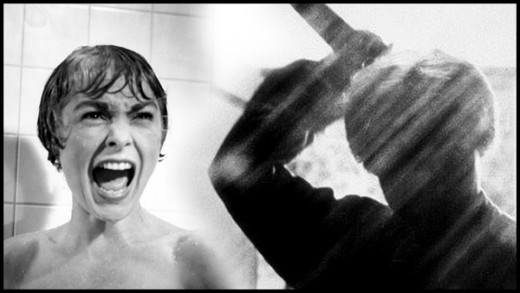"Psycho and the Dissociative Identity Disorder"

Psycho by Robert Block was published in 1959. Norman Bates is a bachelor, who lives with his mother; a puritanical, old, domineering woman. Together they run a small motel in the town of Fairvale. They are having a heated fight when a customer arrives, Mary Crane, a young woman who is on a run after stealing $40,000 from a client in order to get married with her boyfriend, Sam Loomis. She accepts Bates’ invitation to dine together, an invitation that makes Mrs. Bates mad. During the dinner Mary suggests that Norman should put his mother in a mental institution, but he denies it saying to her that “We all go a little mad sometimes’’. Mary returns to her room and takes a shower, where a figure looking like an old woman appears to her, holding a butcher knife and stabs her to death. Norman after being drunk and passed out, finds her corpse and immediately he thinks that his mother is the murderer. His mother ‘comforts’ him and he decides to dispose of the corpse. In the meantime, Mary’s sister Lila and Sam are trying to find her with the help of Milton Arbogast, a private investigator. He tries to talk to Mrs. Bates, but as he enters the house, the figure who killed Mary kills him too with a razor. Sam and Lila visit Fairvale to look for him and meet with the town sheriff. They found out from him that Mrs. Bates has been dead for years, having commited suicide by poisoning herself and her lover. The young Norman went to a mental institution after finding them. Sam and Lila investigate the motel. Sam distracts Norman and Lila is searching on her own. Norman tells Sam that his mother was pretending to be dead. Bates hits Sam with a bottle. Lila is scared to discover the mummified corpse of Mrs. Bates, in the fruit cellar. Norman dressed like his mother (the previous murderous figure) tries to kill her but Sam subdues him. At the police station Sam learns that Norman, years before, killed his mother and her lover after being extremely jealous of their affair. He is found insane and being locked in a mental institution for life. The ‘mother’ personality completely possesses him and in a great plot twist it is revealed that the murderous personality was Norman’s and the mother was harmless.
The film adaptation, based on the novel by Robert Block, is a 1960 American psychological horror thriller, directed and produced by Alfred Hitchcock. It was written by Joseph Stefano and filmed on a low budget.. The cast included Antony Perkins, Janet Leigh, John Gavin, Vera Miles and Martin Balsam. It received mixed reviews, especially in the beginning, for its raw depiction of violence and sexuality, but had incredible box office returns, which led to four Academy Award nominations and two Oscars for Best Supporting actress, Janet Leigh, and Best Director, Alfred Hitchcock. It was ranked as one of the greatest films throughout the movie history, mainly because it introduced a new slasher film genre. The soundtrack of the film by Bernard Herrmann had also a great success.
Robert Block was inspired by the horrific case of Edward Gein. In 1968 in Plainfield, Wisconsin, Gein was found guilty for murdering two women, Mary Hogan, in 1954, and Bernice Worden, in 1957. Gein was insane; a shy man suffering from the Oedipus complex, originating from his mother-love, and turned into a spree of murders, cannibalism and grave robberies. According to Skipp (2012), a true homicidal psychopath racked with guilt and torment,yet driven to destroy women before they can destroy him.
From Robert Block’s Psycho comes the character of Norman Bates. He is an alcoholist, addicted to pornography, with repressed sexuality. He is a man so strongly attached to his demanding, puritanical and possessive mother that is unable to live his own life. Norman experiences bizarre attraction to her, hatred and restraint, typical terms in the description of someone who has the Oedipus complex. According to Freud (1899), the desire for sexual involvement with the parent of the opposite sex is a result of repressed sexual instincts. Norman seems to be aware of their condition.
[Norman] ‘Psychology isn’t filthy Mother!’
[Mother] ‘Psychology,he calls it!A lot you know
about psychology! I’ll never forget that time
you talked so dirty to me,never.To think that
a son could come to his own mother and say
such things !’
[Norman] ‘But i was only trying to explain something.
It’s what they call Oedipus situation…’ (Block, 5).
After murdering his mother, he is in a total denial of reality and develops a dual personality, in which one side of himself adopts his dead mother. He is possessed by an alien personality although this personality is his dead mother and is the one that has the murderous instinct.
The dissociative identity disorder (DID), known also as multiple personality disorder (MPD), is a mental disorder that causes the appearance of at least two different personalities within the same person. These ‘alters’ have different voices, memories, thoughts, character, instincts,a ges and gender. They can coexist within the same person and cause him the effect of ‘switching’, the transitioning of the same person from one personality to the other, obtaining at the same time the power to control his actions, thoughts, and memories. This is exactly what Norman Bates is suffering from. After a careful observation of his character throughout the text and movie, one can find themselves face to face not only with the actual symptoms of the disorder, but also with their visual representation.
In Robert Block’s text, Norman’s character is exposed from the very first moment while the symptoms of his mental disorder are present as well. He is fighting with his mother for being up late, reading. Through his mother’s words to him we get a glimpse of her character. She is a domineering, sarcastic, austere woman, who tends to point out Norman’s faults. Norman is trying to persuade himself to stand up for his own good:
[Mother] ‘You’re thinking that you’d like to kill me, aren’t you, Norman ?
But you can’t. Because you haven’t the gumption. I’m the one who
has the strength. Enough for both of us’.
[Norman’s head voice]: ‘Tell her to go back to her room and lie down... And
she’d better go there fast,because if she doesn’t, this time
you’re going to struggle her with her own silver cord’
(6).
Since the first scenes of the movie are focused on Marion Crane’s character, we do not see the peculiar personality of Norman Bates from the very beginning. When Mary approaches the Bates Motel we clearly see the Mother’s figure behind the window, and then Norman walking down the stairs. It is a symbolical scene, which could show the ‘shifting’ of his personality. When the two characters talk, Block describes Norman’s reactions as “lowered his voice’, He nodded abruptly, then smiled’ (16). Here, Norman, at least in the beginning, is extremely shy while in Hitchcock’s version, he is more relaxed since he wants to compel the audience to identify with the quiet and shy character, whose devotion to his mother has cost him his own identity and life, using even humour.
However, he hesitates to get in her room. It is like he continuously hears his mother’s puritan voice in his head, telling him that the only woman that he should respect and love is herself. A similar hesitation can be observed when Block’s Norman cannot touch Mary to help her with her coat ‘The poor guy was actually afraid to get near a woman’ (18). He seems to be afraid and hesitant towards the opposite sex; it is not just pure shyness. Later on, the close up to the stuffed bird and his line ‘You eat like a bird’ along with ‘A boy’s best friend is his mother’ are the first lines of the film that clear the ground for the audience for his problematic behaviour. He is engaging himself with a hobby that can be considered quite gothic, especially for a man that is clearly left alone with his old mother, running a vacant motel.
When Mary suggests that he should consider putting his mother in a mental institution, Norman’s voice changes from apologetic and soft to defensive, high and violent ‘She’s not crazy!’. ‘And the pudgy man was on his feet, his hands sweeping a cup from the table. It shattered on the floor, but Mary didn't look at it; she could only stare into the shattered face’(Block 18). The change of Norman’s attitude in the movie is depicted mostly in Perkins’ look. He seems completely offended and devastated by the idea ‘She’s harmless’, ‘She’s not a maniac’. He is in a complete denial of his situation and seems like he is actually being offended for himself than his own ‘mother’. His abrupt shift of mood depicts his confusing mind and probably it is an early sign for his dual personality ‘All of us go a little crazy at times’ (19). Before the famous pivotal shower scene, we vision him revealing a hole under a painting on the wall, through which he is watching Mary getting undressed. His repressed sexuality leads him to spy on her for sexual pleasure or it could be interpreted as an attempt to understand the physicality of the opposite sex, which scares him and causes him dubious feelings.
The reader/audience is now face to face with Marion’s murder and Norman’s insanity.
Then she did see it there just a face, peering through the curtains, hanging in midair
like a mask. A head-scarf concealed the hair and the glassy eyes stared inhumanly,
but it wasn't a mask, it couldn't be. The skin had been powdered dead-white and
two hectic spots of rouge centered on the cheekbones. It wasn't a mask. It was the
face of a crazy old woman.
Mary started to scream, and then the curtains parted further and a hand appeared,
holding a butcher’s knife. It was the knife that, a moment later, cut off her scream.
And her head. (Block 21).
In the book, through the eyes of Mary, the murderer is described as an old woman with inhumanly eyes staring at her. She is also wearing a headscarf and has heavy makeup on her.
‘I’ll kill her!I’ll kill the bitch!’ (22). Block gives to the reader the false hint for who the real murderer is, only to hide the protagonist’s mental disorder and its extent. The murder scene is surprisingly similar in both versions but there is also a striking difference. The Norman of the book is much more violent than the one in the movie, as the old woman- Mrs. Bates-Norman decapitates Mary. On the other hand, Marion is being stubbed to death and left to bleed out. Moreover, Norman in the book passed out before the murder. That could be considered as a symptom of his mental disorder as it is part of a complete denial of the reality. He commits his crimes while on a deep unconscious ‘sleep’. We come across the extent of his problem, when both in the movie and book, we see him shocked and devastated by the murder that he immediately attributes to his mother “She wasn’t really responsible. She was sick” (27). Without knowing it, he reassures himself that nothing is wrong and the real villain is the illness.
All the panic, all the fear, all the horror and nausea and
revulsion, gave way to this overriding resolve. What had happened was tragic,
dreadful beyond words, but it would never happen again. He felt like a new man—
his own man.”
The door to Mother's room stood open, and lamplight fanned forth into the hall.
He stepped in, not bothering to knock. No need to pretend any more. She couldn't
get away with this. She couldn't get away. But she had. The bedroom was empty.
(26).
Norman after his ‘mother’s’ crime is cleaning off the blood. The cleaning is cathartic for his own personality, as it seems that in this way he washes off his guilt ‘Turning Mother in to the police wouldn't help alter the situation either’ (29). He seems to find their situation hopeless.
Mother had done that to him. Mother had done that to the poor, helpless girl. She
had taken a butcher knife and she had hacked and Ripped nobody but a maniac
could have committed such an atrocity. He had to face facts. She was a maniac.
She deserved to be put away, had to be put away, for her own safety as well as
the safety of others. (32)
Norman in Block’s text is having an epiphany of the malevolent character of his mother masking his own guilt and denying strongly the facts. He is starting drowning in his dual personality and creates the profile of the true killer that he believes is his mother. A sign of total confusion in mind as his two personalities are struggling together creating the platform of the victim-victimizer.
The house was the place where she belonged you couldn't trust Mother around
strangers, not any more. And the less they knew about her, the better. (Block 51)
Private Investigator Arbogast with the help of Lila, Marion’s sister and her boyfriend Sam, is trying to find the missing woman. He is questioning Norman about her. He seems distracted and agitated while he is mumbling than clearly talking. A proof not only of guilt but his mental condition too as he feels an extreme pressure. A while before the investigator gets violently murdered by Norman dressed up like his mother, Block puts his character into a realization of the harm that could cause but it is again directed to his mother.It is probably Norman’s fear too and the feeling of being unable to control the other personality along with its actions. The investigator’s pressure on him and the questions about Marion, his crime,reinforces his denial and the evil personality of his mother is unleashed for a second time.
And it was just a moment.
Mother opened the door and Mr. Arbogast walked in. He looked at her
and then he opened his mouth to say something. As he did so he raised his
head, and that was all Mother had been waiting for. Her arm went out and
something bright and glittering flashed back and forth, back and forth --
It hurt Norman's eyes and he didn't want to look. He didn't have to look,
either, because he already knew. Mother had found his razor. ( 59-60).
If I didn't love you, do you know where you'd be today?" He didn't want to say it,
but he had to. "The State Hospital for the Criminal Insane. That's where you'd be."
He snapped out the light, wondering if she'd heard him, wondering his words had
gotten through to her, even if she had. Apparently she understood. Because just as
somehow he closed the door she answered. Her voice was deceptively soft in the
darkness, but the words cut into him; cut into him more deeply than the straight
razor had cut into Mr. Arbogast's throat. "Yes, Norman, I suppose you're right.
That's where I'd probably be. But I wouldn't be there alone." (Block 63)
One of the differences between the original text and the movie is the frequency of the voice of Norman’s mother inside his head that is being described like he is actually talking to her. Through the book, the voice comes as a moment of epiphany. In both versions the voice appears in scenes of great crisis. Even though we encounter the ‘voice’ less in the movie the scenes are vivid and epitomize Norman’s dissociative identity disorder. After Mr. Arbogast’s death, Norman has another moment of realization as he tells his mother that she should be in “The State Hospital for the Criminal insane” by now. He does not only understand her situation but he replies with the help of her personality to himself that he should be there too. The two personalities are finding a common ground at this point.
Lila and Sam are trying to find Mary and investigator Arbogast. The revelation of Norman’s dissociative disorder is close as his ‘mother’ too. After talking to the Sheriff , they learn that Norma Bates is dead years ago.
"I already told you I was there, at the funeral. I saw the note she left for Bates when
she and this Considine fella killed themselves. What more do you want? Do I
have to dig her up and show her to you?" (73)
The reader/audience is puzzling over the murderer’s true identity since the mother is dead while it becomes pretty obvious that Norman is not worthy to sympathize with.He is the puzzle now that has to be solved.
Lila and Sam find a torned paper in the movie and an earring with blood on it in the book and realize that something happened to Mary. Convinced that the nervous and weird Bates, or a woman that dresses up like his mother, hides something Sam tries to distract him to help Lila search the place.Norman tries to “hide” his alter personality and seems to succeed it. “The bitch. They were all bitches. Listen to her, now.” (79). Norman is angry and confused but at the same time confident as his logical thinking leads him to the apparent:he has to hide the “mother”.
Having the feel that he being attacked and especially mentally Norman talks to Sam about his mother before the great revelation.
She screamed when she saw the old woman lying there, the gaunt, gray-haired old
woman whose brown, wrinkled face grinned up at her in an obscene greeting. "Mrs
Bates!" Lila gasped. "Yes." But the voice wasn't coming from those sunken,
leathery jaws. It came from behind her, from the top of the cellar stairs, where the
figure stood. Lila turned to stare at the fat, shapeless figure, half-concealed by the
tight dress which had been pulled down incongruously to cover the garments
beneath. She stared up at the shrouding shawl, and at the white, painted, simpering
face beneath it. She stared at the garishly reddenedlips, watched them part in a
convulsive grimace. "I am Norma Bates," said the high, shrill voice. And then there
was the hand coming out, the hand that held the knife. (91)
When Norman is exposed by Lila and Sam , “the mother in him takes over completely and the Norman personality is obliterated.”According to Sam in the text and The psychiatrist in the movie Norman Bates no longer exists. “I am Norma Bates”.The manifestation of his split personality. Norman lost the battle with his alter personality,it is over and the dominant one,won “She was the only one left, and she was real’(Block 98). He is completely taken over by the other half which in his case is his mother.We learn that his mother is the murderer of two other little girls. Ten years ago unable to face his mother’s affair with another man than him he murdered her. His inability to accept her death and his crime led him to erase the event from his mind.He was dressing up like her to keep alive the illusion that his mother was still alive, preserved her body ,talked like her. He found some measure of solace by thinking that his mother was still close to him. Norman was extremely jealous of his mother’s affairs, his mother’s personality is the one that kills primarily young women to whom Norman is attracted.In this way he developed a dual personality. An Oedipus complex example of modern literature and film history, one could assume that Norman’s personality was bulit upon the schema of a weak little boy, the absent father and the domineering mother.
There is also, a main difference concerning the way of how Norman’s dissociative identity disorder is represented in the text of Robert Block and Hitchcock’s movie. Block’s text describes three personalities, “alters”; the young weak boy, the adult Norman and the mother, whereas, Hitchcock focuses only on the mother and less to the adult Norman, setting completely aside the young boy.
She sat there for quite a long time, and then a fly came buzzing through the bars.
It lighted on her hand. If she wanted to, she could reach out and swat the fly.
But she didn't swat it. She didn't swat it, and she hoped they were watching, because
that proved what sort of a person she really was. Why, she wouldn't even harm a fly. . . .”
In both versions at the end we observe a schema considered to be used by Hitchcock “The criminal has always done his crime for another, the true criminal has done his crime for the innocent man who, whether we like it or not, is innocent no longer”(Peirce 201).
BIBLIOGRAPHY
• Block, Robert. “Psycho.”1 May.2016.PDF file.
• Psycho. Universal Pictures, 1998. Videocassette.
• Deleuze, Gilles. Cinema 1: The Movement Image. Trans. Hugh Tomlinson and Barbara Habberjam. Minneapolis: University of Minnesota Press, 1986
• Kawin,Bruce F.Horror and the horror film.Cambridge:Cambridge University press ,2012
• “Oedipus complex”. Encyclopædia Britannica. Encyclopædia. Encyclopædia Britannica Inc., 2016. Web. 01 Jun. .
• Piper, A., 1996, Hoax and Reality: The Bizarre World of Multiple Personality Disorder Lanham, MD: Jason Aronson, 1996.








